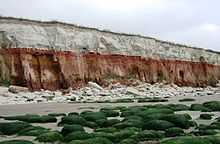Carrstone
Carrstone (or carstone, also known as Silsoe and gingerbread) is a sedimentary sandstone conglomerate formed during the Cretaceous period. It varies in colour from light to dark rusty ginger. Used as a building stone it can be found in Bedfordshire, Cambridgeshire and extensively in the historic buildings of North-west Norfolk.[1][2]
Carrstone can vary in quality depending on factors such as the degree of iron oxide present, and sufficient pressure to form the matrix. Because of its variations it does not lend itself to carving or finer work.[3] Carrstonework can be seen in buildings as: random carrstone, coursed carrstone, ashlared carrstone, all with, or without, galleting. Other patterns of use are: rough carrstone sipps (slips or brickettes) and cut carrstone sipps, both used in masonry fields between
brickwork quoins.[4]
Examples of carrstone work can be found on St Mary's Church, Barton Bendish as well as many other parish churches in the region.[5] Hunstanton and Wolferton feature some interesting examples along with the 'Gingerbread Town' of Downham Market, notably the Grade II Listed Downham Market railway station.
Petrography of carrstone formation
Ferruginous sandstone with detritial framework grains. Quartz dominated with subordinate feldspar, glauconite and sporadic phosphatic grains.[6]
Silver carr
Silver carrstone is similar to ginger carrstone in all but colour and ferrous content.
Carrstone iron ore
East Anglia has had only four workable pockets for iron production. The Carrstone found in Norfolk at Ashwicken and West Runton was considered viable for iron smelting by the Romans.[7] There is also evidence of smelting carrstone in the 14th century at Blakeney Chapel. These were nodular ores which were burnt by the direct method with charcoal in a bloomery furnace with forced air; the iron bloom was taken from the furnace as a spongy mass which was filled with unwanted impurities, these were worked (wrought) out by hand to produce wrought iron.[8]
Carrstone quarries
Historically, there have been numerous carrstone quarries along the Carrstone belt.[9][10] Snettisham Carrstone quarry in Norfolk is still active and produces high iron content building stone.[11]
Conservation of carrstone buildings
Carrstone, as with many other building stones, is vulnerable to decay.[12] There are many factors which influence the life of carr building stone such as the bedding mortar,[13] moisture control[14] and orientation of stone.[15] Appearance of carr building stone can also be affected by factors such as mortar colour, mortar inclusions, stone shade, orientation in the wall, galletts and shapes of stone.[16]
Construction methods
Carrstone can be used in much the same way as any other building stone, but with the disadvantages of friability[17] and of being more difficult to cut by hand. Whilst the stone is used as a single leaf for newbuild to reflect the more vernacular buildings, it is more common to see traditional methods of construction which involve an inner and outer leaf with a rubble core fill. This type of wall is referred to as 'solid wall construction', but this is a misleading description due to the two leaves and core fill having different properties from a true solid wall, which is more susceptible to condensation and other damp mechanisms such as penetrating and rising damp.
References
- ↑ University of Southampton Archaeology, Stone in Archaeology Database.
- ↑ Messent, C.W.J, Rev. 1967, A Thousand Years of Norfolk Carstone 967-1967, Fletcher & Sons.
- ↑ Clifton-Taylor A,& Simmons, J. 1987. The Pattern of English Building
- ↑ Hart, Stephen. 2008, Flint Flushwork, a Medieval Masonry art, p25, Boyden Press.
- ↑ Allen, R.L, 2004, Carrstone in Norfolk Buildings, Archaeopress.
- ↑ http://www.nora.nerc.ac.uk retrieved 15-3-2011
- ↑ Tylecote, RF, 1986, The Prehistory of Metallurgy in the British Isles, Institute of Metals, London.
- ↑ Tylecote, RF, 1992. A History of Metals 2nd ed., Institute of Metals. 46-57, 62-66.
- ↑ Taylor & Francis 1835, Philosopical Magazine & Journal of Science P. 177-179. London
- ↑ http://www.naturalengland.org.uk
- ↑ http://www.build.uk Retrieved 22 March 2011
- ↑ Ashurst, J&N,1998, Practical Building Conservation, Volume 1, English Heritage, London.
- ↑ SPAB, 2002, Technical Pamphlet 5 Repointing Stone and Brick Walling, London
- ↑ SPAB, 1998, The Control of Damp in Old Buildings, London.
- ↑ Ashurst,J&N,1998, Practical Building Conservation, Volume 1, English Heritage, London
- ↑ Ashurst, J, & Francis, D, 1998. Conservation of Building and Decorative Stone. Butterworth-Heienmann
- ↑ Brewster, D., Taylor, R., Philips, R., 1835, Philosophical Magazine & Journal of Science VII p177-179
